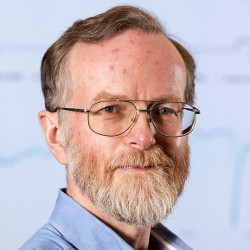
Every day in the United Kingdom hundreds of power stations, thousands of substations, and millions of kilometers of cable come together to power our homes, offices, transport, and more. Yet we only take notice of this when something goes wrong. Now that’s happening at a wider scale—global warming, forest fires, extreme weather events, and so on.
We must stop burning stuff in large power plants and make more use of renewables. Yet, the sun won’t shine more brightly, nor the wind blow more fiercely just because we have hit a light switch—the underlying control assumption for the entire system is different.
I came into the energy sector in 2013, when Nesta, an innovation foundation in the U.K., ran a challenge prize to engage domestic consumers with “demand side response,” that is, adjusting their energy consumption to match the generation available. This is critical if we are to integrate high proportions of solar and wind energy onto the grid. I suggested using the cloud to coordinate thousands of smart, IoT-connected devices. (We subsequently patented aspects of this idea, about how we scaled it to handle huge numbers of devices in real time.)
During the course of the challenge, I joined up with three computer science graduates from Lancaster University to build a prototype. We also submitted grant applications to the U.K. government. After winning a couple of those, we figured there must be something to our idea and we formed a company: Upside Energy. Things snowballed from there. Over the next four years, Upside grew to employ 35 software engineers and data scientists and raised £10m of grant and equity finance. Together we built a cloud service capable of coordinating hundreds of thousands of domestic appliances, home batteries, electric vehicles, among others, to make the best use of renewable energy on the grid.
I stayed with Upside through this growth and financing, helping it recruit a management team after the Series A venture capital funding in late 2017. Once that team was in place, I handed over the company and got back to my passion—helping people use technology to create a better world. I’m now supporting a number of local and municipal energy projects in the U.K. and EU, mentoring a couple of energy-tech startups, and working on regulatory initiatives that are helping to define our path to a net-zero energy system.
All of this was possible because of my 30 years’ experience as a systems engineer. I started in image processing, then data acquisition and control for large, experimental scientific systems, and then on to commercial command-and-control systems. Eventually, I shifted into games. (Some people think this is a big shift, but graphics is mostly just image processing in reverse.) From there I went into consulting for organizations like Greenpeace, Oxfam, Cisco, Intel, Skype, and Vodafone (on developing software-intensive products). All of which gave me the building blocks to found a startup.
Why do I do this? What gets me out of bed in the morning?
Three things: First, it’s the opportunity to build something beautiful. Sometimes the beauty is hidden from all but the specialist’s view, but it’s there.
Second, I want to make the world a better place. We have enormous power to change the world through the systems we create. A world with clean air and water in which every person is respected seems like something we can all aspire to. Let’s use our power to build something we can be proud of as we pass it on to coming generations.
Third, it’s about welcoming more and more computer scientists into the industry. The depth of talent and passion that is coming through in our teenagers and 20-year-olds is exciting and fills me with hope—even in these times of climate crisis and Covid-19.




Join the Discussion (0)
Become a Member or Sign In to Post a Comment